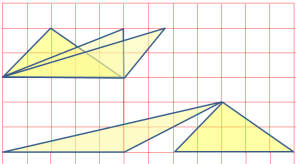In Math investigation about polygons and algebraic expressions I presented possible problems that students can explore. In this post, I will share some ideas on how the simple investigation of drawing polygons with the same area can be used as an introductory lesson to teach operations with algebraic expressions with meaning and understanding. Like the rest of the lessons in this blog, this lesson is not so just about learning the math but also making sense of the math and engaging students in problem solving.
The lesson consists of four problem solving tasks to scaffold learning of adding, subtracting, multiplying and dividing algebraic expression with conceptual understanding.
The diagram below are just some of the ways students can find the area of the polygons.
The solutions can be represented by the algebraic expressions written below each polygon. Draw the students’ attention to the fact that each of these polygons have the same area of and that all the seven expressions are equal to
also.

Problem 2 – (Ask students to draw polygons with a given area using algebraic expressions with two terms like in the above figure. For example a polygon with area .
Problem 3 – (Ask students to do operations. For example .)
Note: Whatever happens, do not give the rule.
Problem 4 – Extension: Draw polygons with area 6xy on an x by y unit grid.
These problem solving tasks not only links geometry and algebra but also concepts and procedures. The lesson also engages students in problem solving and in visualizing solutions and shapes. Visualization is basic to abstraction.
There’s nothing that should prevent you from extending the problem to 3-D. You may want to ask students to show the algebraic expression for calculating the surface area of solids made of five cubes each with volume . I used Google SketchUp to draw the 3-D models.

Point for reflection
In what way does the lesson show that mathematics is a language?




